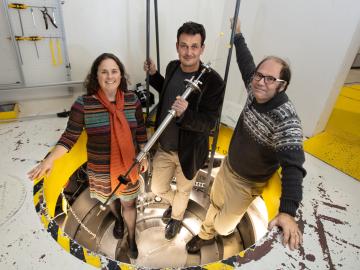
Filter News
Area of Research
- Advanced Manufacturing (3)
- Biology and Environment (51)
- Biology and Soft Matter (1)
- Computational Biology (1)
- Computer Science (1)
- Energy Frontier Research Centers (1)
- Energy Science (80)
- Fusion and Fission (11)
- Fusion Energy (1)
- Isotope Development and Production (1)
- Isotopes (24)
- Materials (78)
- Materials for Computing (13)
- National Security (24)
- Neutron Science (101)
- Nuclear Science and Technology (13)
- Quantum information Science (2)
- Supercomputing (45)
News Type
News Topics
- (-) Advanced Reactors (25)
- (-) Clean Water (19)
- (-) Composites (24)
- (-) Cybersecurity (31)
- (-) Isotopes (55)
- (-) Nanotechnology (50)
- (-) Neutron Science (139)
- (-) Space Exploration (16)
- (-) Transportation (61)
- 3-D Printing/Advanced Manufacturing (108)
- Artificial Intelligence (114)
- Big Data (58)
- Bioenergy (95)
- Biology (108)
- Biomedical (61)
- Biotechnology (36)
- Buildings (50)
- Chemical Sciences (72)
- Computer Science (180)
- Coronavirus (37)
- Critical Materials (17)
- Education (5)
- Element Discovery (1)
- Emergency (3)
- Energy Storage (80)
- Environment (162)
- Exascale Computing (64)
- Fossil Energy (7)
- Frontier (61)
- Fusion (56)
- Grid (50)
- High-Performance Computing (114)
- Hydropower (6)
- ITER (6)
- Machine Learning (53)
- Materials (113)
- Materials Science (120)
- Mathematics (9)
- Mercury (9)
- Microelectronics (4)
- Microscopy (44)
- Molten Salt (5)
- National Security (81)
- Nuclear Energy (99)
- Partnerships (67)
- Physics (65)
- Polymers (25)
- Quantum Computing (48)
- Quantum Science (80)
- Security (30)
- Simulation (54)
- Software (1)
- Statistics (3)
- Summit (62)
Media Contacts

Rigoberto “Gobet” Advincula has been named Governor’s Chair of Advanced and Nanostructured Materials at Oak Ridge National Laboratory and the University of Tennessee.

Liam Collins was drawn to study physics to understand “hidden things” and honed his expertise in microscopy so that he could bring them to light.

Researchers have developed a new process that could make it much cheaper to produce biofuels such as ethanol from plant waste and reduce reliance on fossil fuels.

Illustration of the optimized zeolite catalyst, or NbAlS-1, which enables a highly efficient chemical reaction to create butene, a renewable source of energy, without expending high amounts of energy for the conversion. Credit: Jill Hemman, Oak Ridge National Laboratory/U.S. Dept. of Energy

While Tsouris’ water research is diverse in scope, its fundamentals are based on basic science principles that remain largely unchanged, particularly in a mature field like chemical engineering.

A technology developed at the ORNL and scaled up by Vertimass LLC to convert ethanol into fuels suitable for aviation, shipping and other heavy-duty applications can be price-competitive with conventional fuels

An international team of scientists, led by the University of Manchester, has developed a metal-organic framework, or MOF, material

Students often participate in internships and receive formal training in their chosen career fields during college, but some pursue professional development opportunities even earlier.

Oak Ridge National Laboratory will give college students the chance to practice cybersecurity skills in a real-world setting as a host of the Department of Energy’s fifth collegiate CyberForce Competition on Nov. 16. The event brings together student teams from across the country to compete at 10 of DOE’s national laboratories.

Scientists at the U.S. Department of Energy’s Brookhaven National Laboratory have new experimental evidence and a predictive theory that solves a long-standing materials science mystery: why certain crystalline materials shrink when heated.


